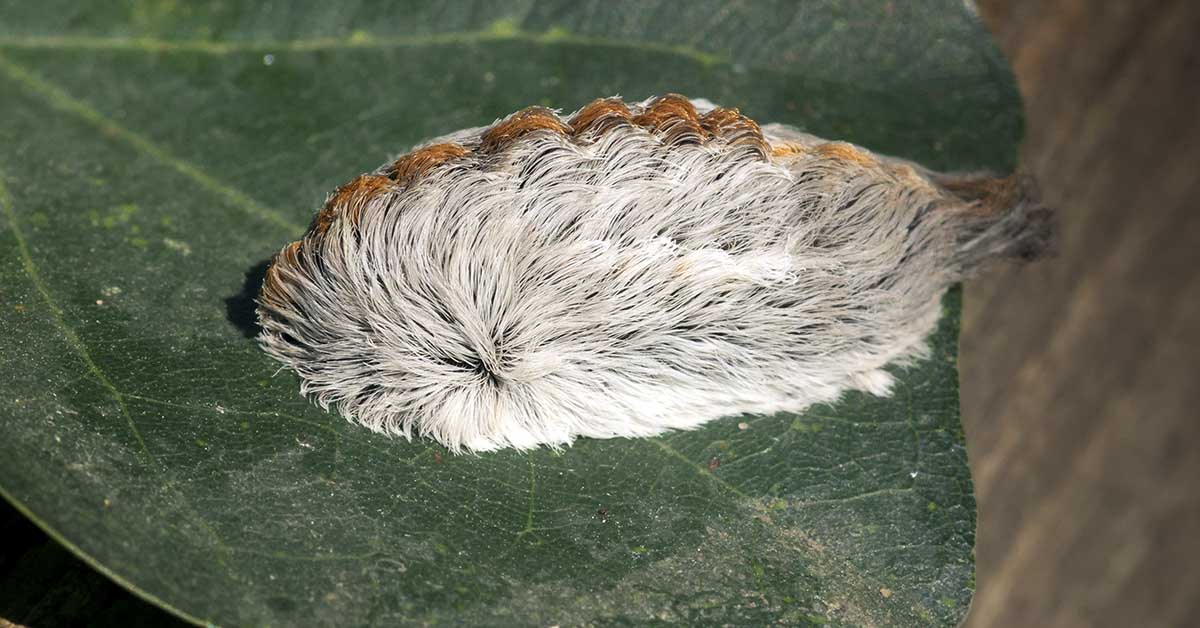Leslie Howe inadvertently saved her children from a painful sting. They was sitting on a bench at Gwinnet County Park when they noticed a strange creature beside them. “I’ve never seen anything like that before,” said Howe. “It looked like a cross between a rodent and a caterpillar.” However, it was a venomous puss caterpillar.
As she videotaped the creature with one hand and held her infant with the other, she told her kids to look but don’t touch. Later on, she learned how good that instruction was. “That could have been extremely painful for one of them — especially the baby,” said Howe. “I don’t know what kind of damage it could have done.” [1]
How to Treat Stings From Puss Caterpillars
Puss caterpillars appear in states between Florida and New Jersey, and as far as Texas. People tend to stumble across them in the fall and spring. Most encounters that result in a sting are accidental, like when a caterpillar falls out of a tree or a person accidentally touches one while gathering leaves.
Despite their furry appearances, puss caterpillars are not cute and cuddly. Their soft-looking hair actually hides small and very toxic spines that could get stuck in your skin. “A puss caterpillar sting feels like a bee sting, only worse. The pain immediately and rapidly gets worse after being stung, and can even make your bones hurt,” said University of Florida entomologist Don Hall. “How bad the sting hurts depends on where you get stung and how many spines are embedded in your skin. People who have been stung on the hand say the pain can radiate up to their shoulder and last for up to 12 hours.” [2]
Hall himself had experienced the sting several times. Most of them had come from young puss caterpillars he cared for in his garage; the young ones usually have less spines than the older ones. Although the stings can be painful, there’s no specific medical procedure for them. But Hall recommends covering the wound with scotch tape and ripping it off to take out any spines still stuck in the skin. Then one should gently wash the site with soap and water. If the skin itches, apply hydrocortisone cream or a paste made of baking soda and water. Ice packs and oral antihistamine can also help with the pain.
Although a sting usually results in a blister or irritated skin, some people may suffer more adverse reactions from the venom. Particularly those who tend to have extreme reactions to insect bites. “Some may just have localized discomfort that lasts for just a short period of time. Others could have something as severe as anaphylaxis or needing to seek medical attention,” said entomologist Molly Keck of the Texas A&M AgriLife Extension Service. [3] Therefore, if the sting becomes increasingly painful or other symptoms appear, seek immediate medical attention. There have been rare cases where the sting cause anaphylaxis, which could be life-threatening.
More About Puss Caterpillars
Puss caterpillars become southern flannel moths as adults, and they exhibit more unique features. For instance, females take hairs from their own abdomen to cover their eggs. “Those hairs are not venomous, but presumably protect the eggs from natural enemies in some way,” Hall said. Flannel moths also fling their excrement away from themselves. Hall theorizes that this behavior is to keep away parasites who are attracted to feces.
Another interesting behavior is that puss caterpillars eat their cast-off exuviae after molting. This prevents predators — namely other insects — from tracking them using the dead skin. Plus, it gives some nutrition to the growing larvae. And after puss caterpillars become southern flannel moths, other creatures use their discarded cocoons. Different species of ants and spiders have been found laying eggs in these old cocoons. [4]
Sources
- “Stinging venomous caterpillars prompt warnings in southeast.” WUSA9. Jerry Carnes. September 10, 2014
- “Toxic ‘Toupee’: Explaining the Most Venomous Caterpillar in the U.S.” National Geographic. Carrie Arnold. September 16, 2014
- “Despite its innocently furry appearance, the puss caterpillar’s sting is brutal.” NPR. Dustin Jones. September 7, 2022
- “Common name: puss caterpillar (larva), southern flannel moth (adult).” University of Florida Department of Entomology and Nematology. Donald W. Hall. February 2019

